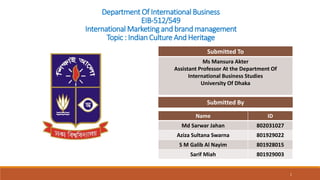
Indian Culture.pptx
- 1. Department Of International Business EIB-512/549 International Marketing and brand management Topic : Indian Culture And Heritage Name ID Md Sarwar Jahan 802031027 Aziza Sultana Swarna 801929022 S M Galib Al Nayim 801928015 Sarif Miah 801929003 Submitted By Submitted To Ms Mansura Akter Assistant Professor At the Department Of International Business Studies University Of Dhaka 1
- 2. 2
- 3. Introduction: India has the oldest civilization in the world. The subcontinent of India lies in South Asia, between Pakistan, China and Nepal. Second most populous nation in the world. Indian culture is very similar to its vast geography. Culture in India is related to life customs, values, ethics, habits knowledge, etc. Birthplace of a lot of religions. Coordination of many different cultures in the Indian subcontinent. Culture is seen in everything like social norms, food, fashion, music, dance etc. 3
- 4. Communication Greetings Hello/goodbye salutation Namaste There are 17 principal languages More than 200 (some texts report up to 300) dialects spoken in India. English is the official language; Hindi is the national language 4
- 5. Indian languages and literature Northern Indian languages & literature Persian and urdu Hindi literature Bengali, assamese and ortya literature Gujarati literature Sindhi literature Marathi literature Kashmiri literature 5
- 6. Cultural identity, religion, region and ethnicity India cultural identities are based on various factors such as religion and region As a result each Indian possesses multiple identities. Even in the forms of worship and rituals there are sectarian and regional differences. Different religions may have common regional cultural traits like language, food, dress, values and also the worldview. 6
- 7. Culture and civilization & heritage Civilization means having better ways of living. The culture of a particular region can be reflected in religion, art, dance, literature, customs, morals, music, philosophy, etc. On the other hand, the civilization is exhibited in the law, administration, infrastructure, architecture, social arrangement, etc. The important characteristics of Indian Culture are civilized communication, beliefs, values, etiquette, and rituals. India is well known for its 'Unity in Diversity' across the world. That means India is a diverse nation where many religious people live together peacefully having their own different cultures. 7
- 8. Cultural believe in India Religious Believes Political Believes Caste System Modern India 8
- 9. Social Structure in India In Indian social structure, the identity of the people is greatly influenced by their: Gender Religion Place of birth Local language
- 10. Tribes in India Tribe’ refers to the group of people with similar interests and values with a head or leader. In Indian tribal system, the head or leader is often referred to as Raja or king. Tribes are separated from each other based on some distinct features such as Common names Common territory Endogamy Political organization
- 11. Caste Structure in India In Indian caste system, The caste of a person, designated by the term ‘jati’ meaning birth, refers to a strictly regulated community into which they are born. In ancient India, a person’s ‘Varna’ (color) was responsible for the distinction. Brahmans, they were at the top of the social hierarchy, in descending prestige, Kshatriyas, Vaishya's and Shudras were at the bottom. This caste system brought some regulations upon the people within the castes while choosing Jobs, social and religious rituals, marriage and also while choosing friends.
- 12. Social Classes in India Agrarian Class Structure ◦ Large farmers (10 hectares and above); Medium farmers (between 4 to 10 hectares); Small-Medium farmers (2-4 hectares); Small Farmers (1-2 hectares); Marginal Farmers (less than 1 hectare) Industrial Class Structure ◦ The Industrial class structure in India came to existence during British era along with mercantile middle class and a new bureaucratic administrative class. Middle Classes in India Nearly 55% of the Indian population is expected to join the ranks of the middle class till 2025.
- 13. Marriage in Indian Culture Traditionally marriages were arranged by the parents of the couple belonging to the same caste but from different ‘gotras’. Mostly monogamous marriages were followed but polygamy was not prohibited. Under the modern laws, polygamy has been made illegal. Hindu marriage Act was amended in 1986 and prescribed the age of marriage of girls as 18 years and for boys as 21 years.
- 14. Women in Indian Society Women in India have seen progressive decline of their status. Except for some personal property women were not entitled to any property or Vedic education. Since Independence, many laws and policies have been introduced to ensure the betterment of women in society such as the Hindu Marriage Act of 1955 and the recognition of daughter’s share in her father’s property by the supreme court.
- 15. Conclusion Gradual changes have been ushered in by religious, social, and cultural reforms. Industrialization, urbanization, and technological advances have been instrumental in changing family structures, values, and lifestyles. India is a country of great legends where many great people were born and remembered forever due to their sacrifice for the nation. Yet even these days, people across the world come to enjoy and feel the culture and tradition of India.